
by Peter Boyles | Nov 19, 2018 | Blasting with Boyles
 I call for my pipe and I call for my bowl — Dan Caplis that’s an inside joke. In the spirit of giving and God bless us all, looking back over the last 12 months of the award-winning Glendale Cherry Creek Chronicle columns, I am remiss if I don’t wish most of my targets a Merry Christmas with a gift under their trees.
I call for my pipe and I call for my bowl — Dan Caplis that’s an inside joke. In the spirit of giving and God bless us all, looking back over the last 12 months of the award-winning Glendale Cherry Creek Chronicle columns, I am remiss if I don’t wish most of my targets a Merry Christmas with a gift under their trees.
Beginning with Kyle Clark and Shaun Boyd — Now you can see where this column is headed. Dudes — the numbers bite, you cut a lot of throats this year and both of you act surprised that the only person people dislike more than you two is me.
To the employees of The Denver Post — In the words of Dick Kreck, if they offer you a buy out, take it fast. It won’t be much but it will be a little something so you can buy yourselves a little holiday cheer.
To the Hickenlooper-Hancock Road Home to End Homelessness in Ten Years — My father would talk about putting one thing in one hand and something in the other and seeing which weighed the most. You can also attempt to shovel that same substance against the tide. You both deserve it put on the tops of your heads. When was the last time anyone drove Speer Boulevard and saw how Denver is ending homelessness.
To John Elway and Joe Ellis — Do you guys know the expression something is much like “Hogan’s goat?” Damn, dudes. Can’t you guys — in the words of Rodney King — just get along?
To the Bowlen family — Talk about why can’t we all get along. I’m sure it will be a really fun Christmas morning at Annabel’s.
To Stan Garnett — Stanley where are you my boy? You were the darling of new left media and now you have vanished like Marley’s ghost. Can they hear your chains rattling through the hallowed halls at Brownstein’s?
To Norm Brownstein — A true Father Christmas to the great state of Colorado. If the Broncos could have only had the year you had. You had more hits than the mafia. Sometimes I think of myself as what if I really am Whitey Bulger? That’s never good.
To Michael Hancock — who is, as I’m sure, all settled down for a long winter’s nap. It just depends who he’s with. Could be about anybody, right Mikey?
How about that John Hickenlooper — President-elect Hickenlooper? Contender Hickenlooper? Senator John Hickenlooper? If you watch the horizon John Boy’s future is so bright — here comes the gift — sunglasses, he’s gotta wear shades.
Jared Polis — or should I say Governor Jared Polis? Your win over Walker Stapleton is the equivalent of stepping on baby chicks — whoops that’s an Easter gift.
The NFL — I love that you decided to have a whole week where you saluted the military. Was that some feeble attempt to bring people back to watching your on-field performances? A special New Year’s wish for that.
And last but not least — Donald Trump. The gift that keeps on giving. How you managed these last two years is absolutely amazing. I never got the pony under the tree and I certainly never got a car. But I got you. You have made these last two years a true enjoyment watching CNN’s rating drop below the Food Channel reruns. Don Lemon is getting clipped by the Cupcake Wars. Damn what a Christmas gift that is.
So looking ahead to 2019, in the words of my sainted grandmother, if you don’t think things are going to get worse, just wait and hang on. Merry Christmas, Kwanzaa, Hanukkah, and Happy New Year. Thank you for this last year — it’s been a blast.
— Peter Boyles

by Mark Smiley | Nov 12, 2018 | Feature Story Bottom Left
 Density vs. The Neighborhood Balancing Affordable Housing And Community Safety
Density vs. The Neighborhood Balancing Affordable Housing And Community Safety
by Amanda Sawyer, Candidate for Denver City Council, District 5
All eyes have been on the November elections, but now the focus shifts to May 2019, when Denver will choose who should fill the 15 spots that will make up our next Mayor, City Council and County Clerk. There are already 45 candidates running for those 15 positions, so you can tell people in Denver are not happy with the current leadership. And the biggest issue on everyone’s mind is affordable housing.
When it comes to the cost of living in Denver, we are a city in crisis. Historically, “affordable housing” is defined as one third of average median income. This is a particularly big deal in neighborhoods with high incomes, because middle income earners like teachers and first responders can’t afford to live there. And there are not enough local housing options for retirees on fixed incomes when they are ready to cash out of their homes and move. We need more affordable housing, especially in these neighborhoods. But where should it go? And, what are the other unintended consequences such as traffic and infrastructure issues?
City planners will tell you that the solution is to build high-density developments along transit corridors. We have already seen this in East Denver in developments like 9th & Colorado and Boulevard One. The problem with this solution is the streets that the City considers to be “transit corridors.”
Let’s look at Holly Street. It is considered a transit corridor, so planners want to add density there. To be fair, there may be places on Holly where added density could work. But to make a blanket generalization that all of Holly Street — a two lane road that runs through neighborhoods filled with families, small businesses and schools — should be developed because the City considers it a transit corridor? That doesn’t make sense.
Take, for example, the Green Flats proposal, on Holly between Cedar and Alameda. The design is attractive, and I appreciate the developer’s attention to green building. He has also been generous with regards to privacy, setbacks, and the number of parking spaces. In another location, this is an excellent project. But, it’s not a good fit for this particular block.
The current development plan provides for 35 parking spaces, accessed solely via the alley that runs from Alameda to Cedar. There are approximately 11 vehicles using that space now, so this would add 24 cars. According to neighbors, the southern entrance to the alley is dangerous because people drive Alameda at high speeds and the alley isn’t clearly visible. They already have to wait for a red light at Alameda and Holly before they can pull out. Their other option is to use the northern entrance to the alley at Cedar between Hudson and Holly. The businesses on that block offer amenities specifically to draw families to the location, so there are always kids at that entrance. The bike racks and cornhole games are located no more than 20 feet from the alley that would be the only vehicle access to this development. It’s already a dangerous situation and 24 more cars will make it worse.
Adding more cross-traffic at Cedar and Holly is also a bad idea. There is no logical way to put a stoplight at this intersection. It would cause a bottleneck that would back up northbound traffic on Holly down onto Alameda and Leetsdale. The City already acknowledged there is essentially no solution to this problem when it installed a flashing crosswalk at this intersection. I’ve personally seen multiple people almost killed in that crosswalk. The proposed development and the additional 24 more cars it will bring to this already highly congested area don’t make sense.
Holly will also be virtually unusable dur-ing the construction phase of this project. While that is temporary, it will force drivers to use the neighborhood streets as our main north-south roads. This will create a safety risk for the neighborhood kids, especially on streets like Fairfax and Dahlia that connect Alameda to 6th Avenue. And, remember, this project is proposed three blocks from the playground of a Denver Public Elementary School which families with young children use every day as their main entrance to the school grounds.
In addition to traffic and safety issues, the proposed development has had the unfortunate effect of driving out other residents. One neighbor has already moved. The property immediately to the south is for sale. Other neighbors have told me they will move if the project is approved. In this case, even the beginning proposal stage has already caused at least two residents to leave the neighborhood, which is a shame.
Finally, I’m concerned that this developer wants to seem like he’s compromising without actually compromising. I experienced this attitude personally while researching the Green Flats project. and I’m not alone. When concerns about the project size were brought up in mediation, the developer’s concession was to lower the number of units from 27 to 23. This seems like a fair compromise; except as I understand it, he intends to combine units that were originally designed as single units into larger units with more bedrooms. If true, this would lower the officially measured density of the project without actually altering its size. As I write this no one has seen revised plans for the project so the truth of that remains unclear. But if the information is correct, the post-mediation “change” is a distinction without a difference.
And, more importantly, it is indicative of a concerning business culture among the development community, where a spirit of camaraderie and partnership with the neighborhoods seems to be lacking. It’s time to change the conversation. Solving Denver’s housing crisis is the most important issue we face. Denver has to add density. We need to come together to find creative solutions. But do we have to add to our existing traffic issues, give up the character of our neighborhoods and the safety of our children, to do it? The final hearing for the Green Flats Project is scheduled for November 7.
To comment, attend the final hearing for the Green Flats Project November 7 at 3 p.m. at 1437 Bannock St. #379. Amanda Sawyer is a licensed Colorado attorney and MBA. She and her husband are raising their kids in East Denver, and she is running for Denver City Council District 5 because she believes we need fresh eyes on the issues that face our neighborhoods. You can find out more about her platform at www.sawyerforfive.org.
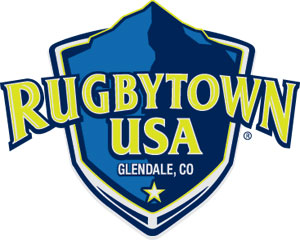
by Mark Smiley | Oct 24, 2018 | Glendale City News
by John Arthur
Writer for and on behalf of the City of Glendale
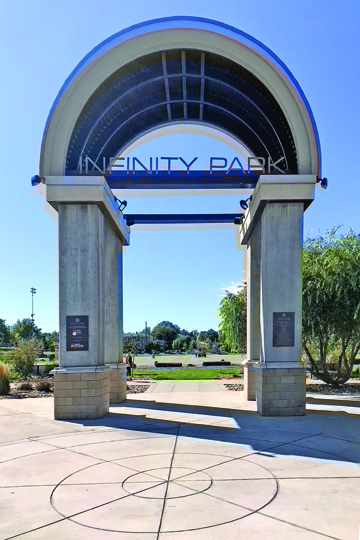
The Infinity Park arch sits just off the turf field in Infinity Park’s open space and just shows you the work of laying the new advanced synthetic grass.
Exciting things are unfolding at Infinity Park this fall, as America’s premier rugby venue recently installed a new, state-of-the-art turf playing surface ahead of welcoming the top women’s rugby sevens teams on the planet for an Olympic-qualifying tournament, in addition to ushering in a second season of professional men’s play in Major League Rugby. Though tournament competition was held on Infinity Park’s natural grass pitch, the new turf saw plenty of practice action over the weekend tournament, felt the cleats of the pro Raptors side as they took on the Utah Warriors, and will be the battleground for amateur and divisional play for many years to come.
The sole U.S. venue for the HSBC World Rugby Women’s 7s Tournament Series in 2018-2019, the installation of the new turf at Infinity Park was completed just days before the October competition kicked off. An important part of the route to qualification for the 2020 Tokyo Summer Olympic Games, the USA Women’s Sevens tournament represents the highest level of competition on the globe. The reemergence of rugby sevens in the 2016 Rio Olympics massively impacted interest in the sport, earning tens of millions of fans as sevens action received Olympic glory for the first time in nearly a century.
The HSBC tournament has enjoyed a massive increase in viewership in just the last 12 months, with millions of broadcast and social media views and triple-digit percentage growth in overall audience. Twelve international teams competed in the October tournament, co-hosted by Glendale and USA Rugby, including the United States, Russia, Spain, Australia, New Zealand, England, France, Ireland, Canada, Fiji, China, and a 2018-19 invitational side from Mexico. Alongside the Olympic qualifying competition was a Saturday beer festival, featuring dozens of local Colorado breweries, cider makers, and distillers. Championship rounds took place October 21, and served as the first hints at which international teams will represent their countries at the 2020 Tokyo Games.
Ahead of the competition, and with the assistance of a sizeable grant from Arapahoe County, Glendale installed a new turf playing surface. Including the latest player-safety technology, Infinity Park’s new turf field meets World Rugby regulation 22, which not only requires laboratory, manufacturer, and on-site testing, but also allows competition to take place from the local to international level with the full confidence that the preservation of participant welfare won’t be a concern. A top priority for the premier rugby governing body on the planet, as well as the coaching and training staff at Infinity Park, the new surface adheres to the highest standards of competition and safety.
More dependably useful for all levels of play, the material installed in October is better at preventing injury because it is softer, deeper, and more technologically advanced than the original Infinity Park turf it replaces, employing a unique and proprietary Desso iDNA X 60 artificial grass with a Pro-Play drainage shock pad. The Desso system, one of the first installed at a rugby-specific facility in the United States, uses what the company calls a three-dimensional resilience system, meaning that the synthetic grass will long retain its shape and will improve in quality through intensive use. The fibers are light reflective, delivering the much more natural appearance of lush green grass when compared to other synthetic turf.
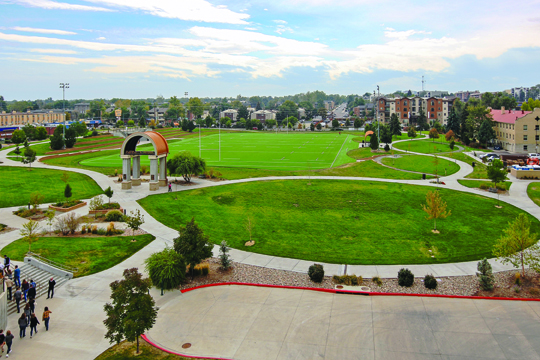
The view from the top of the City of Glendale’s High Altitude Training Center, shows the new turf field is complete and ready for competition. Photo by Justin Purdy
Josh Bertrand, veteran Supervisor of Glendale’s Public Works Department, overseer of installation, and a consummate wealth of knowledge on all things related to Infinity Park, says that in addition to meeting World Rugby regulations, added safety is the most important feature of the new field: “This surface will play better and last longer. It will give additional peace of mind to parents and active youth that use Infinity Park, while also protecting our divisional and professional athletes from injury.” The Pro-Play pad uses thermal bonded, cross-linked polyethylene foam that combines exceptional fall protection and drainage properties. The same product is used by international sporting federations that include field hockey, soccer, and Gaelic and American football, among others. World Rugby field regulations are stringent, and stipulate that high-impact contacts with the turf — like some of the “flying tackles” that make rugby so exciting for fans — are more easily absorbed. Glendale’s brand new, bright green surface will be safely absorbing player contact for years.
Co-hosted by Glendale and USA Rugby, October’s Women’s Sevens tournament brought the number of 2018-2019 tournament rounds to six, providing increased competition and promising more opportunity on the road to Tokyo in the summer of 2020. The HSBC USA Women’s Sevens Tournament at Infinity Park preceded other international stops on the tour, but once again demonstrated that Infinity Park remains the epicenter of American rugby at every level. With future stops at a total of six locations worldwide, including the U.S., Dubai, Australia, Japan, Canada, and France, it seems that the grass, real or synthetic, might actually be greener in Glendale.
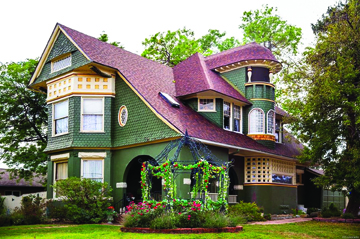
by Mark Smiley | Oct 24, 2018 | Travel
Value Has Grown To $112 Million In Just 12 Months; Complaints Soar As Homes Become The Motel Next Door
by Glen Richardson

Highlands Hot: Unique and nostalgic homes have made short-term rentals in the Highlands neighborhood one of the hottest.
Valley neighborhoods are becoming more and more concerned about short-term rentals by homeowners through Airbnb and others. Their complaint is about the stream of homeowners, some new, renting the house next door for days or up to a few weeks. In neighborhoods such as the Highlands and the Golden Triangle many say the annoyance is progressively on the rise and threatening to escalate into citywide anger and fury.
That’s not a big surprise to Denver: Between January and July of this year the city received 112 complaints concerning primary residence, typically from local neighbors. Furthermore, residents contend that it’s unfair to expect neighbors to be the driving force behind legal compliance.
More than a year and a half after the City of Denver first tried to crack down on short-term rentals, the blossoming industry — buoyed by thousands of new homeowner hosts — has consistently stayed steps ahead of regulators. City records, combined with data provided by Denver-based analytics firm AirDNA reveals incessant problems with the city’s efforts to control a market that is bringing in more than $100 million a year.
Compliance Collapse
According to a study done and reported by BusinessDen — a website for local business news — less than half of the city’s known short-term rental landlords comply with licensing regulations. The bottom line, the study concludes: “The primary-residence requirement, designed to calm the fears of homeowners that their residential neighborhoods could become dominated by the motel next door has proven toothless and largely unenforceable.”
Denver’s Department of Excise & Licenses says the compliance rate is down due to the surge in people listing short-term rentals in the city. That’s because short-term rentals in Denver have grown in value to at least $112 million in the last 12 months. Moreover, it’s expected to top $200 million by 2021. AirDNA figures also show that properties in prime locations have annual cash flow topping six figures.
In only eight years San Francisco-based Airbnb’s initial plan to allow homeowners to host business travelers in a spare bedroom or to rent their family home to tourists while they’re out of town has made it a $25 billion c
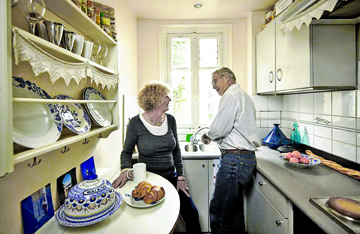
Home Away From Home: Price versus hotels and all the comforts of home have given a big boost in demand for short-term rentals.
ompany. The reason is simple: In comparison to prices for staying in a hotel the cost of a short-term rental is significantly lower. A short-term one-bedroom home in Denver often starts as low as $50 per night. With a hotel there’s typically a bed, a television and maybe a desk and chair. With short-term rentals travelers think they’ve never left home.
Seeking Visitor Dollars
Recognizing the economic benefit to the city coming from short-term rentals Visit Denver — the private, nonprofit association that markets metro Denver — touts on its website that the city has approved and is licensing short-term rentals. The site does urge visitors: “If you are visiting Denver and interested in renting a home, or part of a home, for fewer than 30 days, make sure that you rent from homeowner-hosts who are licensed by the City and County of Denver.”
Denver’s rules don’t allow property owners to run more than one Airbnb location other than a basement or carriage house. Nevertheless, AirDNA records indicate that at least 39% of the city’s properties are offered full-time year-round. More: Another 17% run more than one property. Furthermore, multi-listing hosts account for 40% of Denver’s rentals on Airbnb or about 2,000 listings.
Excise & Licenses has only a single compliance officer to handle 2,200 unlicensed rentals plus another 2,000 listings run by mult

Area Anxiety: Residents worry growth of short-term rentals in Denver’s most popular neighborhoods will change their character and transform the quality of life.
i-unit hosts (prohibited altogether under Denver law). The department’s six inspectors help with short-term rental issues but also deal with the city’s 180 other business licenses plus evolving industries such as marijuana. George Mayl, president of Inter-Neighborhood Cooperation (INC), says it best: “They’re undermanned and understaffed.”
Beginning April 1 of this year Airbnb started collecting Denver Lodger’s tax on sales of short-term lodging. The deal resulted in the city receiving $3 million while not forcing short-term rental property owners to send taxes to the city. During the same period Airbnb made $69 million from rentals. Based on AirDNA data, the city should have received more than $7 million.
Property Value Impact
There is a lot of talk among property owners about short-term rentals and their impact on real estate values. One of the most common questions is do short-term rentals increase the value of a particular residential property? Some homeowners feel it can add as much as 40% to the property value due to generating additional income.
Commercial and residential lenders, however, don’t agree. “A short-term rental has zero impact on value and should not be factored in when evaluating a property.”
Why? Regulations, they argue, can and often change overnight. Moreover they point out that permits are very different than a change in zoning which provides much greater certainty for future buyers of a property. Lenders conclusion: “Don’t buy into the hype that the income from a nightly rental will increase the value of the property.”

Quality Quotient: With 82% of Airbnb properties ranked at least 4.5, the online marketplace now publishes a Quality Score of every Denver short-term rental property.
Investor Influence
While lenders don’t see a benefit to short-term rentals professional real estate investors are far more optimistic. The financial benefit of an Airbnb property is clear to some investors: They can make more money from short-term rentals for the same reason vacationers typically spend more on lodging while traveling than they do on rent.
So how many professional real estate investors list properties on Airbnb? And how large are their businesses?
The best way to see whether there is a major trend of professional investors using Airbnb would be to see how many hosts rent out multiple properties on the site. In Denver at least numbers imply that 40% of listings are from multi-listing hosts indicative of probable professional investors. AirDNA, it should be pointed out, helps real estate investors make short-term rental property investment decisions. Thus the presence of professional investors has become controversial. The upshot is that Airbnb has become close-mouthed about disclosing information.

 I call for my pipe and I call for my bowl — Dan Caplis that’s an inside joke. In the spirit of giving and God bless us all, looking back over the last 12 months of the award-winning Glendale Cherry Creek Chronicle columns, I am remiss if I don’t wish most of my targets a Merry Christmas with a gift under their trees.
I call for my pipe and I call for my bowl — Dan Caplis that’s an inside joke. In the spirit of giving and God bless us all, looking back over the last 12 months of the award-winning Glendale Cherry Creek Chronicle columns, I am remiss if I don’t wish most of my targets a Merry Christmas with a gift under their trees.







